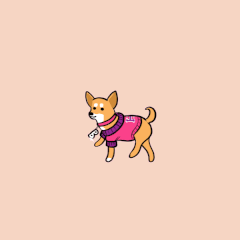- Total $0.00
Top 5 points to consider when choosing a puppy collar
What we cover in this blog?
As a dog parent, it is crucial to give your fur baby a healthy diet, and you should also be keen on selecting important accessories you buy for them. One such must-have accessory is dog collars. They are more than fashion accessories for your puppy. Dog collars are important as they help you to have greater control of your dog while you take them for a walk outdoors.
Yeah, a collar allows you to command your dog's behavior with mild jerks you make with the help of the collar's grip, and this collar becomes an essential feature if you're training your dog. Moreover, by any chance, if your dog becomes separated from you, a collar helps to reunite with you. Of course, they look cute in those collars as well.
So finding that perfect piece that highlights your dog's charisma from a wide range of products can be a little confusing without overlooking the most vital feature of a collar: your dog's comfort and happiness. Seek the best collar and embark on the joyful journey of picking the best one for your puppy.
What type of collar should I get my puppy?
Now that you are ready to choose the dog collars, you need to consider a few essential attributes apart from the various options available.
Based On Dog Breed
The first thing to take into consideration is your dog's breed. Yeah, The ideal collar style for your dog is determined by its breed.
Thinner collars: These are ideal for pups with short necks, such as pugs, Chihuahua, Dachshund, Maltese, and likewise.
Thicker collars: These will give excellent support and comfort to larger dogs like Labrador Retrievers, German Shepherd, Bullmastiffs, and likewise.
Always remember that bigger collars will weigh more, be painful, and cause skin irritation making them unsuitable for little breeds. A regular 1 1/2-inch width collar is the best solution if you are doubtful about your dog's strength. However, you can even find some collars with labels that recommend them for specific breeds according to their size, weight, and fur.
Based On Dog Neck Measurement
After considering the dog breed, we must remember that each dog is unique and has its requirements. So while choosing a dog collar, it is important to measure your dog's neck size and add a few inches to that measurements to ensure that the collar does not become strict on them or cause any pain.
For small breeds weighing less than 10 pounds, add 1 inch
For medium-sized dogs, add 2 inches
For large breeds weighing more than 80 pounds, add 3 inches.
Based on the type of collar
While choosing the collar for your pup, one should also consider the models of collars available and suitable for both your pup and you to train it.
Flat collars: These can come in different materials like leather, nylon, or fabric that are buckle or clip lock. A flat-buckle collar is affordable, comfortable, and an excellent option for attaching tags to your dog.
Martingale collar: It is mostly made of flat material like leather or nylon but connected with metal rings that help tighten and loosen easily when necessary. This collar was designed to keep slim-neck dogs' heads from slipping out, such as Greyhounds, Dobermans, and Whippets.
Head halter: This type can control the dog's skull rather than the neck. It is strongly recommended for owners of giant dogs who may be stronger than them at times.
If you need a heavy collar to train your dog or teach him to walk on a leash, go with a metal choke/slip collar or a metal prong collar. However, continual usage of these collars can harm your dog's neck, throat, and spine.
Harnesses are also great for adult dogs who have not yet learned to walk with a lead. Harnesses make it easier to control your puppy and limit the danger of injury to you and your puppy.
Based on Temperament and training goals
Choosing a dog leash based on your dog's temperament and training goals is always important. For example, pulling dogs requires a training collar, such as a harness or martingale.
Based on your dog's growth
Lastly, if you're choosing a collar for a baby pup, remember to check the tightness continuously as your pup grows. Your two fingers should be able to fit under the collar, and you need to change the collar when it gets tight.

How do you introduce a puppy collar?
Remember, if you suddenly give your puppy a collar and take him for a walk, there's a chance he'll be extremely fearful of going outside. So firstly, it is important to introduce your puppy collar gradually. Initially, you can use cloth tape on puppies' necks until they're used to having something around their necks that will create positive change. Alternatively, you can introduce these collars off and on for them to get habitat. While walking with your dog's collars, start by holding the collar and controlling him with little pressure on his neck. Gradually, you can take over.
What is the ideal time to collar a puppy?
Introducing a collar at the right time is as important as introducing smoothly and gradually, and it is ideal for introducing a collar once your puppy is 8 to 10 weeks old. And while doing so, one needs to consider all the points discussed so far.
Final words
So, while you're checking the best collar for a puppy, we have got all new arrivals light in weight, properly fitted, adjustable, and made of durable materials that distribute pressure evenly around the neck of all varieties right here. However, it would definitely help if you did not leave your dog wearing it for longer durations as this may cause skin issues and even cause your pup to be completely resistant to being controlled with a collar.


